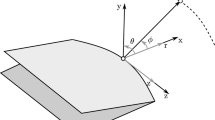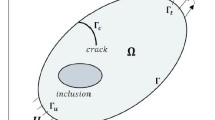Abstract
In this paper, a concurrent simulation framework for fatigue crack growth analysis is proposed using a novel small time scale model for fatigue mechanism analysis and the extended finite element method (X-FEM) for fatigue crack growth simulation. The proposed small time scale fatigue model does not require the cycle counting as those using the classical fatigue analysis methods and can be performed concurrently with structural/mechanical analysis. The X-FEM greatly facilitates crack growth simulation without remeshing requirements ahead of the crack tip as in the classical finite element method. The basic concept and theory of X-FEM was briefly introduced and numerical predictions of stress intensity factors are verified with reference solutions under both uniaxial and multiaxial loadings. The small time scale fatigue model is integrated into the numerical simulation algorithm for concurrent fatigue crack growth analysis. Model predictions are compared with available experimental observations for model validation.
Similar content being viewed by others
References
Sih G C. Multiscale Fatigue Crack Initiation and Propagation of Engineering Materials: Structural Integrity and Microstructural Worthiness. New York: Springer, 2008
Lu Z, Liu Y. An incremental crack growth model for multi-scale fatigue analysis. In: Proceedings of 50th AIAA/ASME/ASCE/AHS/ASC Structures, Structural Dynamics, and Materials Conference Palm Springs, CA, USA. 2009
Pommier S, Risbet M. Time derivative equations for mode I fatigue crack growth in metals. International Journal of Fatigue, 2005, 27(10–12): 1297–1306
Emery J M, Hochhalter J D, Wawrzynek P A, Heber G, Ingraffea A R. DDSim: A hierarchical, probabilistic, multiscale damage and durability simulation system-Part I: Methodology and Level I. Engineering Fracture Mechanics, 2009, 76(10): 1500–1530
Schütz W. A history of fatigue. Engineering Fracture Mechanics, 1996, 54(2): 263–300
Paris P, Erdogan F. A critical analysis of crack propagation laws. Journal of Basic Engineering, Transactions of ASME, 1963, 85: 528–534
ASTM. Standard practices for cycle counting in fatigue analysis. E 1048-85 ASTM International, 1985
Lu Z, Liu Y. Small time scale fatigue crack growth analysis. International Journal of Fatigue, 2010
Béchet E, Minnebo H, Moës N, Burgardt B. Improved implementation and robustness study of the X-FEM for stress analysis around cracks. International Journal for Numerical Methods in Engineering, 2005, 64(8): 1033–1056
Dolbow J, Moës N, Belytschko T. Modeling fracture in Mindlin-Reissner plates with the extended finite element method. International Journal of Solids and Structures, 2000, 37(48–50): 7161–7183
Belytschko T, Black T. Elastic crack growth in finite elements with minimal remeshing. International Journal for Numerical Methods in Engineering, 1999, 45(5): 601–620
Sukumar N, Chopp D L, Moës N, Belytschko T. Modeling holes and inclusions by level sets in the extended finite-element method. Computer Methods in Applied Mechanics and Engineering, 2001, 190(46–47): 6183–6200
Moës N, Belytschko T. Extended finite element method for cohesive crack growth. Engineering Fracture Mechanics, 2002, 69(7): 813–833
Stolarska M, Chopp D L, Moës N, Belytschko T. Modelling crack growth by level sets in the extended finite element method. International Journal for Numerical Methods in Engineering, 2001, 51(8): 943–960
Moës N, Dolbow J, Belytschko T. A finite element method for crack growth without remeshing. International Journal for Numerical Methods in Engineering, 1999, 46(1): 131–150
Dolbow J, Moës N, Belytschko T. An extended finite element method for modeling crack growth with frictional contact. Computer Methods in Applied Mechanics and Engineering, 2001, 190(51–52): 6825–6846
Daux C, Moës N, Dolbow J, Sukumar N, Belytschko T. Arbitrary branched and intersecting cracks with the extended finite element method. International Journal for Numerical Methods in Engineering, 2000, 48(12): 1741–1760
Dolbow J. An extended finite element method with discontinuous enrichment for applied mechanics. Dissertation for the Doctoral Degree. Chicago: Northwestern University, 1999, 1–176
Budyn É, Zi G, Moës N, Belytschko T. A method for multiple crack growth in brittle materials without remeshing. International Journal for Numerical Methods in Engineering, 2004, 61(10): 1741–1770
Khoei A R, Nikbakhta M. Contact friction modeling with the extended finite element method (X-FEM). Journal of Materials Processing Technology, 2006, 177(1–3): 58–62
Sukumar N, Srolovitz D J, Baker T J, Prévost J-h. Brittle fracture in polycrystalline microstructures with the extended finite element method. International Journal for Numerical Methods in Engineering, 2003, 56(14): 2015–2037
Patzák B, Jirásek M. Process zone resolution by extended finite elements. Engineering Fracture Mechanics, 2003, 70(7–8): 957–977
Sukumar N, Chopp D L, Moran B. Extended finite element method and fast marching method for three-dimensional fatigue crack propagation. Engineering Fracture Mechanics, 2003, 70(1): 29–48
Mariani S, Perego U. Extended finite element method for quasi-brittle fracture. International Journal for Numerical Methods in Engineering, 2003, 58(1): 103–126
Liu Y, Mahadevan S. Multiaxial high-cycle fatigue criterion and life prediction for metals. International Journal of Fatigue, 2005, 27(7): 790–800
Lu Z, Xiang Y, Liu Y. Crack growth-based fatigue-life prediction using an equivalent initial flaw model. Part II: Multiaxial loading. International Journal of Fatigue, 2010, 32(2): 376–381
Melenk J M, Babuska I. The partition of unity finite element method: Basic theory and applications. Computer Methods in Applied Mechanics and Engineering, 1996, 139(1–4): 289–314
Soheil M, ed. Extended Finite Element Method. Malden: Blackwell Publishing Ltd. 2008
Bordas S, Legay A. X-FEM Mini-Course. Ecole Polytehnique Federale de Lausanne, 2005
Isida M. Stress-intensity factors for the tension of an eccentrically cracked strip. Journal of Applied Mechanics, 1966, 33(3): 674–675
Porter T R. Method of analysis and prediction for variable amplitude fatigue crack growth. Engineering Fracture Mechanics, 1972, 4(4): 717–736
Author information
Authors and Affiliations
Corresponding author
Rights and permissions
About this article
Cite this article
Lu, Z., Liu, Y. Concurrent fatigue crack growth simulation using extended finite element method. Front. Archit. Civ. Eng. China 4, 339–347 (2010). https://doi.org/10.1007/s11709-010-0078-2
Received:
Accepted:
Published:
Issue Date:
DOI: https://doi.org/10.1007/s11709-010-0078-2




